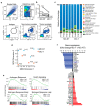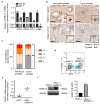Mast Cell-Derived SAMD14 Is a Novel Regulator of the Human Prostate Tumor Microenvironment
- PMID: 33799802
- PMCID: PMC7999778
- DOI: 10.3390/cancers13061237
Mast Cell-Derived SAMD14 Is a Novel Regulator of the Human Prostate Tumor Microenvironment
Abstract
Mast cells (MCs) are important cellular components of the tumor microenvironment and are significantly associated with poor patient outcomes in prostate cancer and other solid cancers. The promotion of tumor progression partly involves heterotypic interactions between MCs and cancer-associated fibroblasts (CAFs), which combine to potentiate a pro-tumor extracellular matrix and promote epithelial cell invasion and migration. Thus far, the interactions between MCs and CAFs remain poorly understood. To identify molecular changes that may alter resident MC function in the prostate tumor microenvironment, we profiled the transcriptome of human prostate MCs isolated from patient-matched non-tumor and tumor-associated regions of fresh radical prostatectomy tissue. Transcriptomic profiling revealed a distinct gene expression profile of MCs isolated from prostate tumor regions, including the downregulation of SAMD14, a putative tumor suppressor gene. Proteomic profiling revealed that overexpression of SAMD14 in HMC-1 altered the secretion of proteins associated with immune regulation and extracellular matrix processes. To assess MC biological function within a model of the prostate tumor microenvironment, HMC-1-SAMD14+ conditioned media was added to co-cultures of primary prostatic CAFs and prostate epithelium. HMC-1-SAMD14+ secretions were shown to reduce the deposition and alignment of matrix produced by CAFs and suppress pro-tumorigenic prostate epithelial morphology. Overall, our data present the first profile of human MCs derived from prostate cancer patient specimens and identifies MC-derived SAMD14 as an important mediator of MC phenotype and function within the prostate tumor microenvironment.
Keywords: SAMD14; cancer-associated fibroblasts; extracellular matrix; mast cells; prostate cancer; tumor microenvironment.
Conflict of interest statement
The authors declare no conflict of interest.
Figures





Similar articles
-
A bioengineered microenvironment to quantitatively measure the tumorigenic properties of cancer-associated fibroblasts in human prostate cancer.Biomaterials. 2013 Jul;34(20):4777-85. doi: 10.1016/j.biomaterials.2013.03.005. Epub 2013 Apr 2. Biomaterials. 2013. PMID: 23562048
-
Protein kinase Ds promote tumor angiogenesis through mast cell recruitment and expression of angiogenic factors in prostate cancer microenvironment.J Exp Clin Cancer Res. 2019 Mar 6;38(1):114. doi: 10.1186/s13046-019-1118-y. J Exp Clin Cancer Res. 2019. PMID: 30841931 Free PMC article.
-
Tissue engineered human prostate microtissues reveal key role of mast cell-derived tryptase in potentiating cancer-associated fibroblast (CAF)-induced morphometric transition in vitro.Biomaterials. 2019 Mar;197:72-85. doi: 10.1016/j.biomaterials.2018.12.030. Epub 2019 Jan 2. Biomaterials. 2019. PMID: 30641266
-
Frenemies in the Microenvironment: Harnessing Mast Cells for Cancer Immunotherapy.Pharmaceutics. 2023 Jun 9;15(6):1692. doi: 10.3390/pharmaceutics15061692. Pharmaceutics. 2023. PMID: 37376140 Free PMC article. Review.
-
Mast cells: A double-edged sword in cancer.Immunol Lett. 2019 May;209:28-35. doi: 10.1016/j.imlet.2019.03.011. Epub 2019 Mar 21. Immunol Lett. 2019. PMID: 30905824 Review.
Cited by
-
Functional requirements for a Samd14-capping protein complex in stress erythropoiesis.Elife. 2022 Jun 17;11:e76497. doi: 10.7554/eLife.76497. Elife. 2022. PMID: 35713400 Free PMC article.
-
hSSB1 (NABP2/OBFC2B) modulates the DNA damage and androgen-induced transcriptional response in prostate cancer.Prostate. 2023 May;83(7):628-640. doi: 10.1002/pros.24496. Epub 2023 Feb 22. Prostate. 2023. PMID: 36811381 Free PMC article.
-
PDK4 Constitutes a Novel Prognostic Biomarker and Therapeutic Target in Gastric Cancer.Diagnostics (Basel). 2022 Apr 27;12(5):1101. doi: 10.3390/diagnostics12051101. Diagnostics (Basel). 2022. PMID: 35626257 Free PMC article.
-
Dynamic polarization of tumor-associated macrophages and their interaction with intratumoral T cells in an inflamed tumor microenvironment: from mechanistic insights to therapeutic opportunities.Front Immunol. 2023 May 12;14:1160340. doi: 10.3389/fimmu.2023.1160340. eCollection 2023. Front Immunol. 2023. PMID: 37251409 Free PMC article. Review.
-
Physiological and regenerative functions of sterile-α motif protein-14 in hematopoiesis.Exp Hematol. 2023 Dec;128:38-47. doi: 10.1016/j.exphem.2023.09.003. Epub 2023 Sep 16. Exp Hematol. 2023. PMID: 37722652 Free PMC article.
References
LinkOut - more resources
Full Text Sources
Other Literature Sources
Molecular Biology Databases

